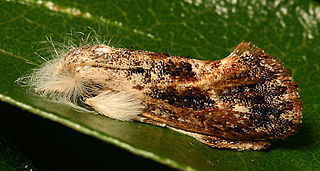
Omphalotus illudens is commonly called the eastern jack-o'lantern mushroom. It is a large orange mushroom that is often found in clumps on decaying stumps, buried roots or at the base of hardwood trees in eastern North America. Nearly all field guides claim its gills often exhibit a weak green bioluminescence when fresh; however, some dispute this entirely as a myth. On the other hand, the green glow, also known as bioluminescence, has been mentioned in several journals, stating that the glow can last up to 40-50 hours after the mushroom has been picked, and that the reason for the green glow is for the fungus to attract insects during the night in order for the insects to distribute the spores throughout the area.

Omphalotus is a genus of basidiomycete mushroom, in the family Marasmiaceae, formally circumscribed by Victor Fayod in 1889. Members have the traditional cap and stem toadstool form. They are saprobic, and fruit in clumps on trees. The best known and type species is the jack-o'-lantern mushroom (Omphalotus olearius). Species of Omphalotus have been mistaken for chanterelles. All Omphalotus species are presumed poisonous, causing gastrointestinal symptoms. Some Omphalotus species have bioluminescent properties.

Acrolophus is a genus of moths in the family Acrolophidae, with, typically, great individual variation within species in color pattern, making field identification of many individuals difficult or impossible. It was described by Felipe Poey in 1832.

Acrolophus popeanella is a moth of the family Acrolophidae. It is found in the eastern United States, from New Jersey and Ohio south to Florida and west to Illinois, Nebraska and Texas.
Acrolophus fervidus is a moth of the family Acrolophidae described by August Busck in 1912. It is found in Costa Rica, Mexico and Texas.

Acrolophus arcanella is a moth of the family Acrolophidae. It is found in eastern North America.
Acrolophus arcasalis is a moth of the family Acrolophidae. It is found in the West Indies.
Acrolophus salvini is a moth of the family Acrolophidae first described by Herbert Druce in 1901. It is found in Panama.

The grass tubeworm or Texas grass tubeworm moth is a moth of the family Acrolophidae. It is found from Maryland to Florida and to Texas.
Acrolophus macrogaster is a moth of the family Acrolophidae. It is found in North America, including Arizona.
Walsingham's grass tubeworm moth is a moth of the family Acrolophidae. It is found in North America, including Alabama, Florida, Georgia, Illinois, Louisiana, Maryland, Mississippi, New York, Ohio, South Carolina, Tennessee, Virginia and West Virginia.
Acrolophus cockerelli is a moth of the family Acrolophidae. It is found in North America, including Arizona, Nevada, New Mexico, Oklahoma, Oregon and Texas.
Acrolophus echinon is a moth of the family Acrolophidae. It is found in Mexico.
Acrolophus mimasalis is a moth of the family Acrolophidae. It is found in the West Indies.
Acrolophus maculata is a moth of the family Acrolophidae. It is found in Brazil.
Acrolophus sinclairi is a moth of the family Acrolophidae. It is found in North America, including California, New Mexico and Texas.
Acrolophus numidia is a moth of the family Acrolophidae first described by Herbert Druce in 1901. It is found in Mexico.
Acrolophus satyrisca is a moth of the family Acrolophidae. It is found in Colombia.

Xerocomus illudens is a species of bolete fungus in the family Boletaceae. Described as new to science in 1898, it is found in Asia and North America, where it grows in a mycorrhizal association with oak.
Acrolophus walsinghami is a moth of the family Acrolophidae. It is found in Puerto Rico.






